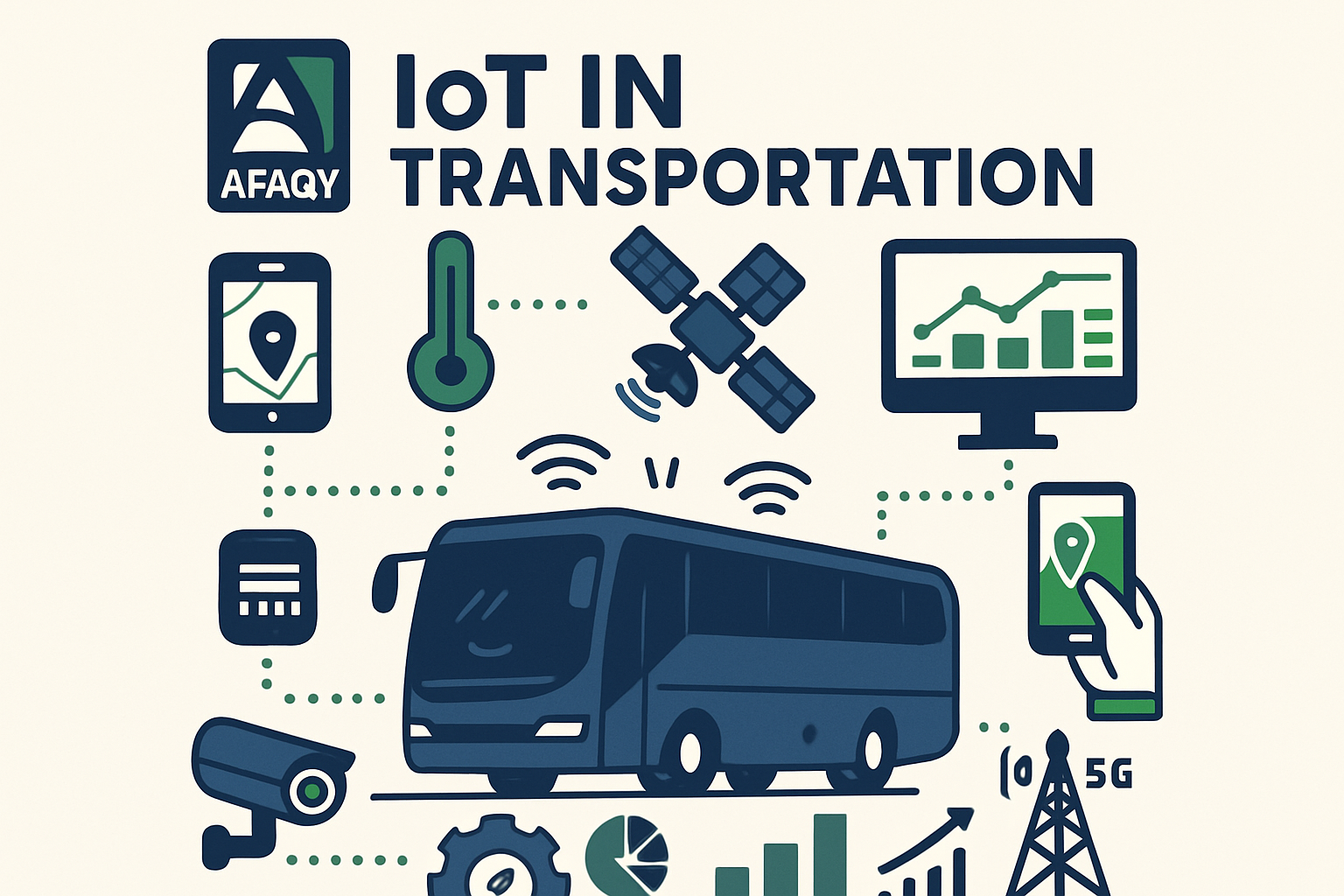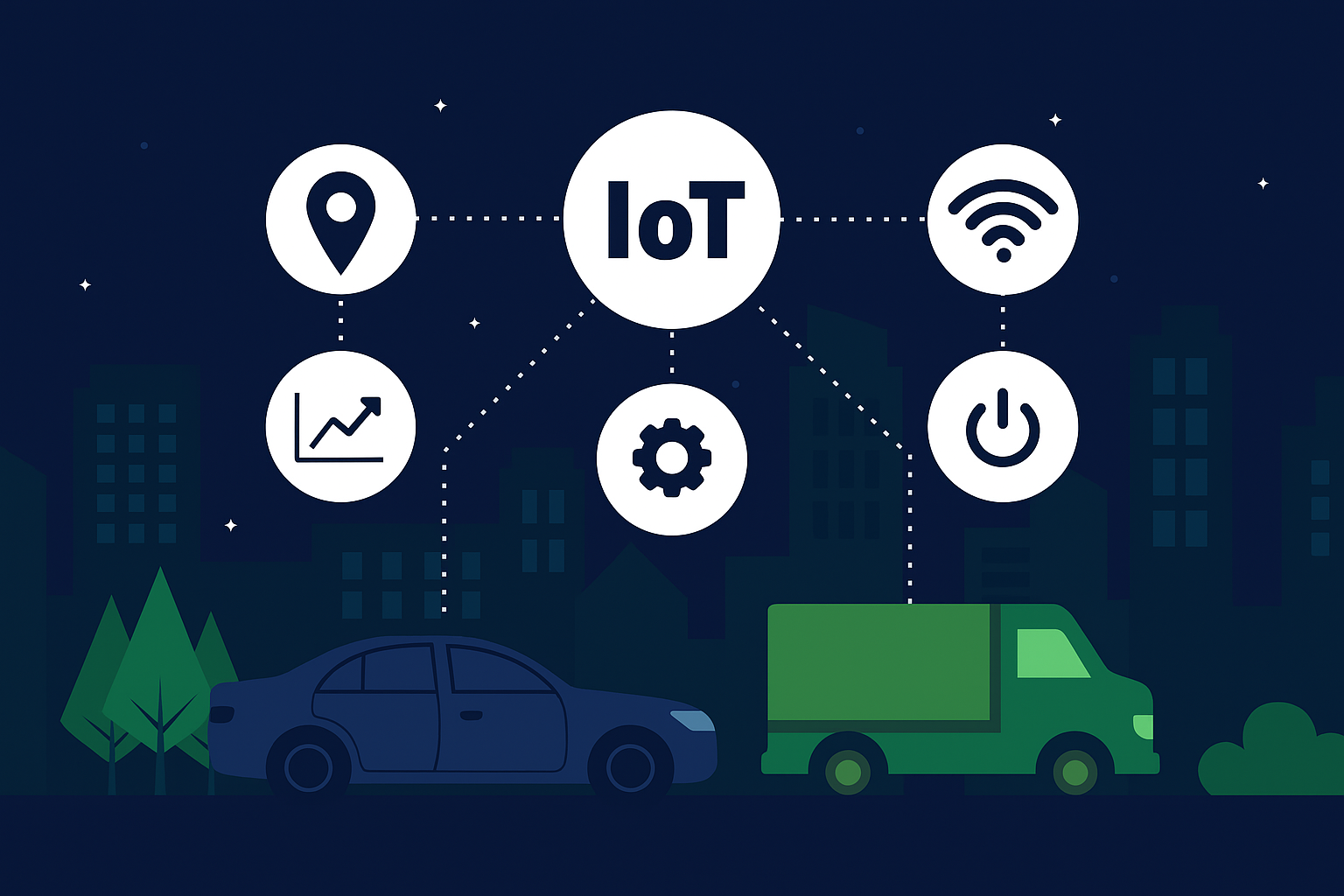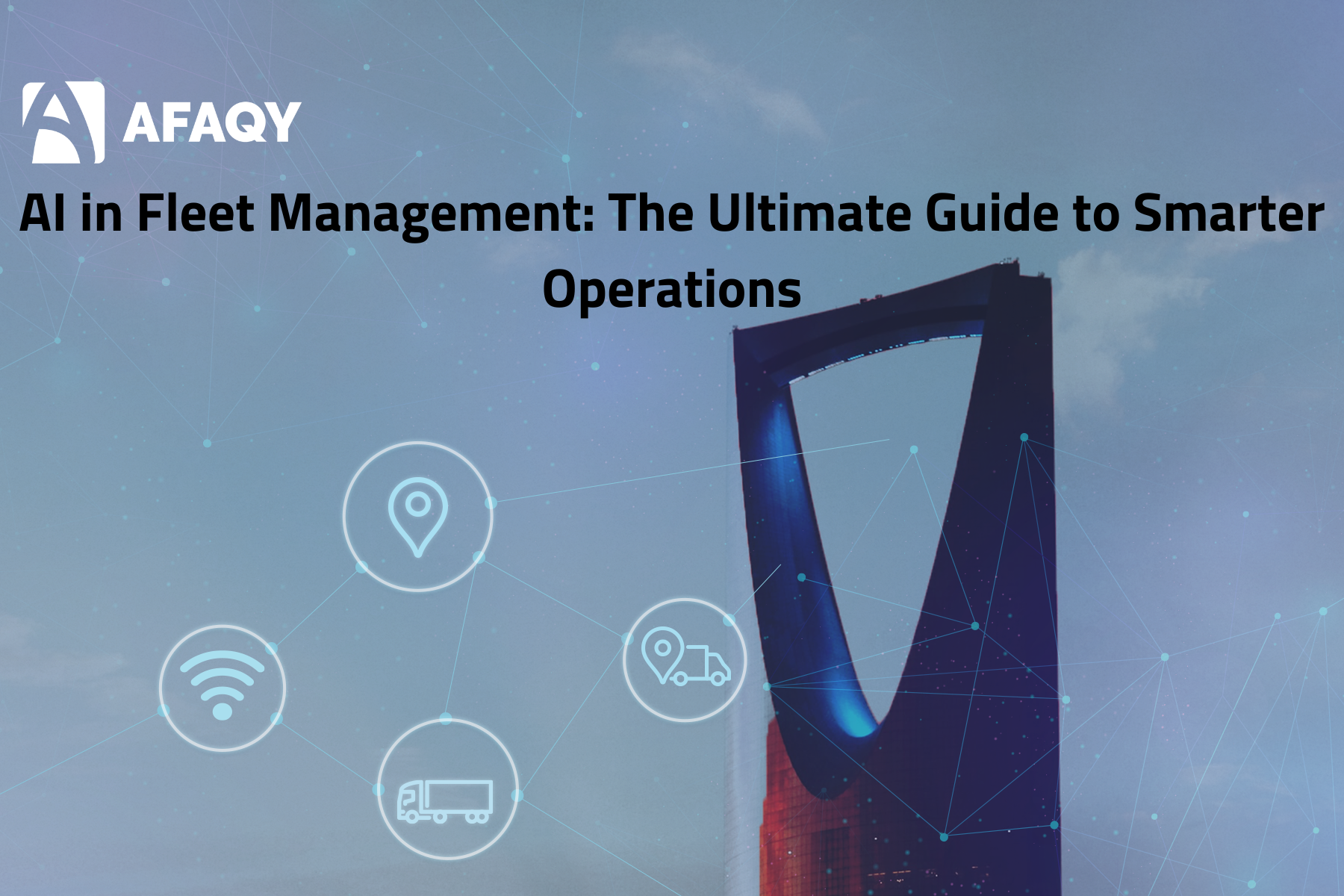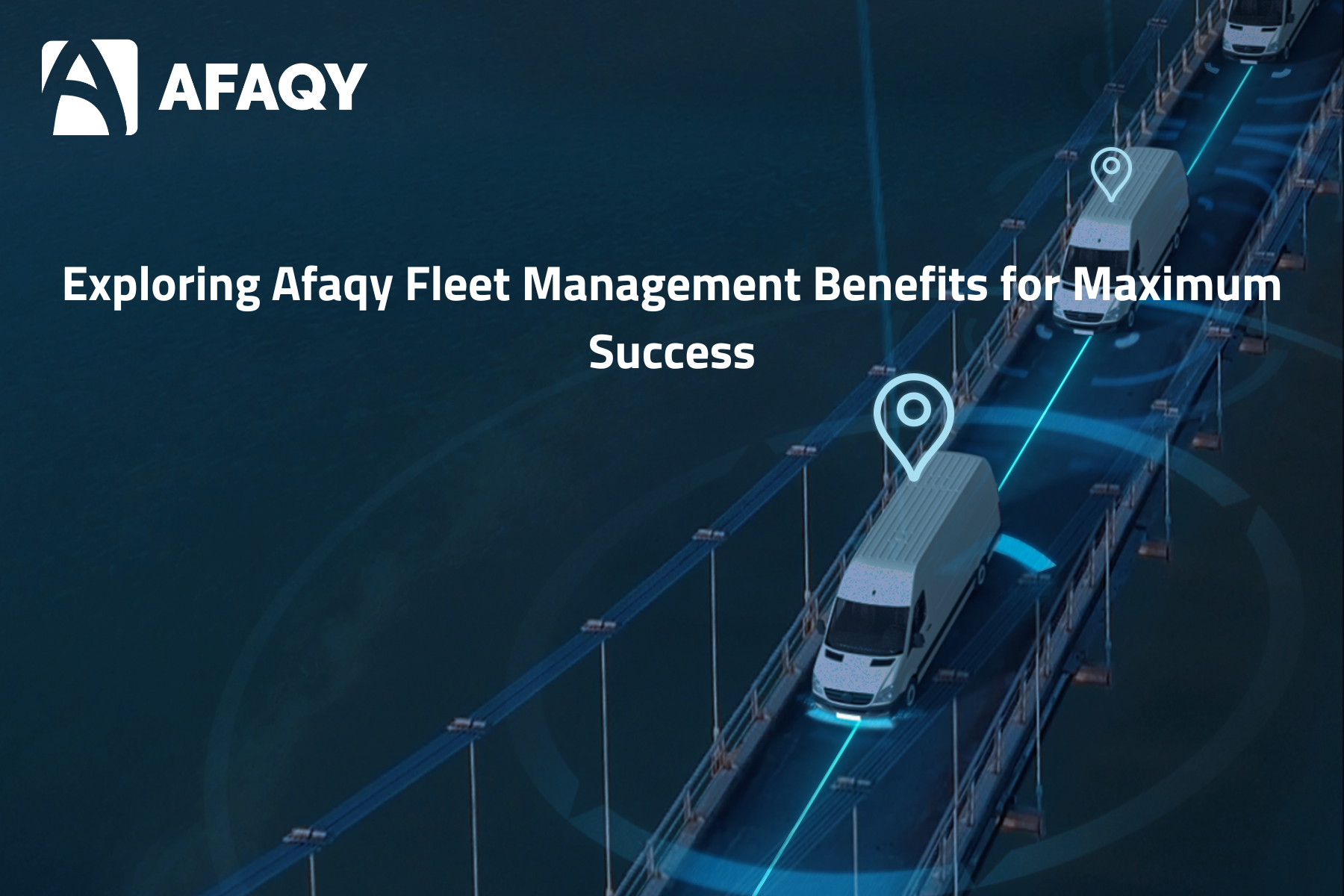IoT in Transportation: How Smart Fleets Are Reshaping KSA Logistics
.png)
IoT in Transportation: How Smart Fleets Are Reshaping KSA Logistics
The global economy runs on the backbone of transportation and logistics, which ensure the seamless movement of goods across borders and continents. As fleets grow and public transportation expands, the need for smarter, safer, and more efficient management has never been more urgent.
That’s why IoT in transportation has evolved from a futuristic idea into a strategic necessity. With the global IoT in the transportation market valued at $83.25 billion in 2020 and projected to soar to $495.57 billion by 2030, transportation and logistics companies are racing to adopt technologies that boost efficiency, visibility, and profitability.
In Saudi Arabia, where Vision 2030 is driving ambitious goals for infrastructure and digital transformation, smart fleet management and IoT fleet solutions are at the heart of a logistics revolution.
From real-time vehicle tracking to predictive maintenance in fleets and route optimization, IoT solutions in Saudi Arabia are enabling businesses to streamline operations, cut costs, and meet rising demand with confidence.
In this article, I will explore how logistics in Saudi Arabia is being reshaped by IoT-powered fleets, and why you should embrace this shift to stay competitive. Scroll down to learn more!
Table of Contents
· What Is IoT in Transportation?
· The Components of IoT Transportation Systems
· 5 Top Benefits of Using IoT Fleet Tracking Solutions
· The Common Use Cases of Smart Mobility Solutions in Saudi Arabia
· Optimize Your Operations with AFAQY’s IoT Solutions
What Is IoT in Transportation?

To put it simply, IoT in transportation refers to the usage of connected devices and sensors that are installed inside fleets to collect fleet data and transmit it to a fleet management system.
Once the data is collected from the connected devices and sensors, it is transformed into valuable fleet insights that fleet managers get from the fleet software to enhance efficiency, optimize routes and enhance safety and passenger experience.
The Components of IoT Transportation Systems
Implementing IoT in transportation requires an ecosystem of technologies that work together to collect, transmit, analyze, and act on data in real time. These components form the heart of smart fleet management, enabling more efficient, safe, and responsive logistics operations. Here’s a breakdown of these components:
1. Smart Sensors and Onboard Devices
At the core of any transportation IoT system are the devices that capture real-world data from vehicles, cargo, and infrastructure. These tools provide critical insights into everything from vehicle performance to cargo conditions and driver behavior. Common devices include:
· GPS trackers: For real-time location tracking
· Environmental sensors: To monitor temperature, humidity, or light for cargo integrity
· Telematics systems: To collect vehicle diagnostics and driver activity
· RFID and barcode scanners: To streamline inventory and asset tracking
· Cameras and LIDAR: To enhance safety, visibility, and autonomous functions
· Weight sensors: To ensure balanced loads and prevent overcapacity
2. Connectivity Technologies
None of the above would function without seamless communication. Connectivity forms the digital highway that links all components, from vehicles to cloud platforms. It enables real-time data exchange and coordination across fleets. Key connectivity tools include:
· Cellular networks: Such as 4G, and 5G for broad-range coverage
· Wi-Fi and Bluetooth: For short-range communication within hubs or depots
· Satellite communication: For remote areas with no cellular coverage
3. Data Analytics and Intelligence Engines
Collecting data is only the first step, and what truly adds value is the ability to interpret it. Advanced analytics tools turn raw data into actionable intelligence by identifying trends, forecasting issues, and optimizing operations. These might include:
· AI-powered analytics platforms
· Machine learning models for predicting maintenance and traffic patterns
· Real-time dashboards for performance monitoring and route optimization
AFAQY’s Fleet includes cutting-edge analytics tools that are able to turn raw data into actionable insights that enhance decision making and allows for effective fleet management.
4. User Interfaces and Applications
To make data usable, it needs to be presented in a practical way. User interfaces such as mobile apps, web portals, and dashboards translate complex analytics into insights drivers, dispatchers, and managers can act on. Examples include:
· Fleet management solutions with real-time tracking and reporting
· Driver mobile apps for task updates and route guidance
· Customer portals for shipment tracking and ETAs
5 Top Benefits of Using IoT Fleet Tracking Solutions

Adopting IoT fleet tracking solutions is no longer just about monitoring vehicle locations; it's about transforming entire logistics operations.
With smart devices, real-time data, and advanced analytics, these systems empower transportation and logistics companies in Saudi Arabia and beyond to boost efficiency, cut costs, and stay competitive in a rapidly evolving market.
Here are the key benefits:
1. Real-Time Visibility and Monitoring
With GPS and telematics data flowing continuously, fleet managers gain full visibility into the location, movement, and condition of every vehicle in real-time. This enables:
· Live tracking of deliveries and shipments
· Improved route compliance and ETA accuracy
· Faster response to delays or incidents
Buraq is an automatic vehicle tracking system developed by AFAQY to provide real-time visibility into your fleets and help you make data-driven decisions. It utilizes advanced tracking technologies including GPS, GIS, GMS, Satellite, and UHF/VHF to cater to the different needs of businesses.
2. Reduced Fuel and Maintenance Costs
According to a study by Frost & Sullivan, IoT-based fleet management systems can reduce fuel consumption by up to 25%.
By analyzing driving patterns and vehicle diagnostics, IoT solutions help cut unnecessary fuel use and prevent costly breakdowns. Key benefits include:
· Early detection of engine issues
· Reduced idle time and harsh driving behaviors
· Smarter scheduling for preventative maintenance
AFAQY’s Fleet stands out with its predictive maintenance feature that allows you to set maintenance schedules, avoid sudden breakdowns, and detect malfunctions before they become big issues. Moreover, it enables you to control fuel consumption by automatically calculating fuel stats for vehicles.
3. Enhanced Driver Safety and Performance
Driver behavior monitoring tools such as speed tracking, harsh braking alerts, and fatigue detection help enforce safety standards, reduce costs, and ensure optimal driver performance. This leads to:
· Fewer accidents and insurance claims
· Safer driving habits
· A culture of accountability and performance
· Reduced costs related to vehicle crashes and increased vehicles’ lifespan
4. Better Customer Experience
A recent study shows that 62% of transportation companies using GPS tracking reported enhanced customer service, while 54% of those using fleet management systems saw similar improvements thanks to fleet tracking technology.
IoT fleet tracking improves communication and delivery reliability and enables logistics providers to:
· Share accurate ETAs with customers
· Offer real-time tracking solutions for shipments
· Proactively manage service delays or rerouting
5. Data-Driven Decision Making
With analytics at the core, IoT solutions turn raw data into insights. Fleet operators can:
· Track KPIs like delivery times, asset usage, and fuel trends
· Make informed decisions for scaling, restructuring, or cost-cutting
· Forecast future logistics needs with confidence
The Common Use Cases of Smart Mobility Solutions in Saudi Arabia
As the transportation and logistics industry continues to evolve, IoT technologies are moving from optional upgrades to critical business enablers. By embedding sensors, connectivity, and analytics into fleets and infrastructure, companies gain real-time visibility, automation, and control across their operations.
Below are some of the most practical and impactful use cases of IoT in transportation and logistics that are reshaping the future of mobility:
Dynamic IoT Fleet Tracking and Route Optimization
IoT devices gather real-time data on traffic congestion, road conditions, weather, and vehicle availability. This enables transportation companies to adapt delivery routes on the fly, reducing delays, and minimizing fuel consumption.
The outcome is improved delivery speed, reduced fuel costs, and better driver productivity.
Remote Vehicle Diagnostics
Instead of relying on routine or reactive maintenance, IoT sensors continuously monitor vehicle components like engine temperature, brake systems, and tire pressure and send alerts when anomalies are detected. This leads to fewer unexpected breakdowns, lower maintenance costs, and prolonged vehicle lifespan.
Enhanced Cargo Condition Monitoring
For sensitive shipments (e.g., pharmaceuticals, food, or electronics), IoT sensors monitor temperature, humidity, shock, and vibration inside trailers or containers.
Any deviation from acceptable thresholds triggers real-time alerts. This is very crucial to Reduce spoilage, increase accountability, and foster safer cold chain logistics.
Streamlined Yard and Warehouse Coordination
IoT devices placed on trailers, forklifts, and loading docks improve visibility across warehouses and yards. This helps coordinate movement, assign loading bays, and reduce congestion.
Connected Vehicles in Saudi Arabia
Modern vehicles are outfitted with a suite of IoT-enabled sensors, cameras, radar, LIDAR, and GPS that enable features like adaptive cruise control, lane keeping assistance, and beyond. These capabilities not only support safer driving but also pave the way for truly autonomous transport.
Smart Parking Management
By embedding sensors in parking zones and integrating them with mobile apps, fleets and private vehicles can receive real-time updates on available spaces. Some systems even allow users to reserve parking spots in advance, reducing circling traffic and wasting time.
Adaptive Traffic Control
IoT systems leverage sensors and cameras installed on roads and intersections to gauge traffic flow, speed, and volume in real time. The data drives dynamic traffic light schedules and rerouting alerts from shortening red lights during congestion to directing drivers through alternative routes during accidents.
Optimize Your Operations with AFAQY’s IoT Solutions
Looking to digitize and streamline your logistics operations from end to end? AFAQY’s cutting-edge IoT solutions empower transportation and logistics companies to gain full visibility and control over their fleets, optimize supply chain visibility and performance, and enhance efficiency across warehouses, assets, and delivery networks.
Whether it’s real-time vehicle tracking, predictive maintenance, warehouse monitoring, or smart inventory management, AFAQY delivers intelligent, scalable solutions tailored for today’s dynamic logistics environment.
Discover how our technology is transforming operations across Saudi Arabia and beyond and contact us today!
FAQs
1. How is IoT transforming transportation?
IoT is revolutionizing transportation by enabling real-time data collection, communication, and automation across vehicles, infrastructure, and operations.
From traffic management to predictive maintenance, IoT systems improve safety, efficiency, and responsiveness, making transportation networks smarter and more adaptable to growing demands.
2. What are smart fleet solutions?
Smart fleet solutions are IoT-powered systems that connect vehicles, drivers, and logistics platforms to optimize fleet performance. These solutions include GPS tracking, telematics, driver behavior monitoring, fuel management, and predictive maintenance, all aimed at improving visibility, control, and cost-efficiency in fleet operations.
3. How does IoT improve fleet operations?
IoT improves fleet operations by enabling real-time vehicle tracking, optimizing routes, monitoring driver behavior, and predicting maintenance needs. It helps reduce downtime, fuel consumption, and accidents while boosting productivity, compliance, and overall fleet performance.
4. How to digitize fleet management in Saudi Arabia?
To digitize fleet management in Saudi Arabia, logistics companies can adopt IoT-based solutions like vehicle tracking systems, telematics platforms, and cloud-based analytics tools. Partnering with local innovators like AFAQY ensures compliance with regulations, integration with regional infrastructure, and alignment with Vision 2030 transport initiatives.
References
1. Allied Market Research, https://www.alliedmarketresearch.com/.(n.d.). IoT in transportation market set for $495.57 bn growth by 2030. Allied Market Research, https://www.alliedmarketresearch.com/, All Right Reserved2025.https://www.alliedmarketresearch.com/press-release/IoT-in-transportation-market.html
2. Zoting, S. (2024, December 2). IoT in transportation market size to hit USD 817.18 bN by 2034. https://www.precedenceresearch.com/iot-in-transportation-market
3. Fong, J. (2019, September 6). How the IoT Will Transform the Transportation Industry. IEEE Innovation at Work.https://innovationatwork.ieee.org/how-the-iot-will-transform-the-transportation-industry/



































.png)


